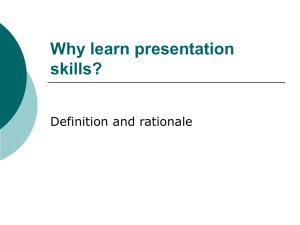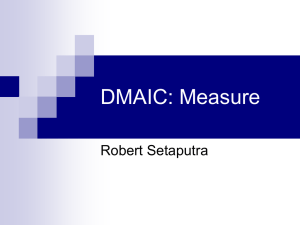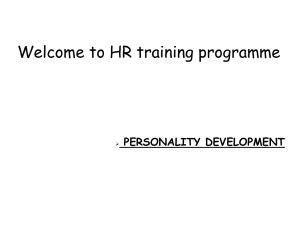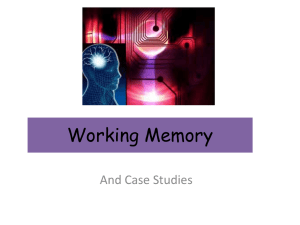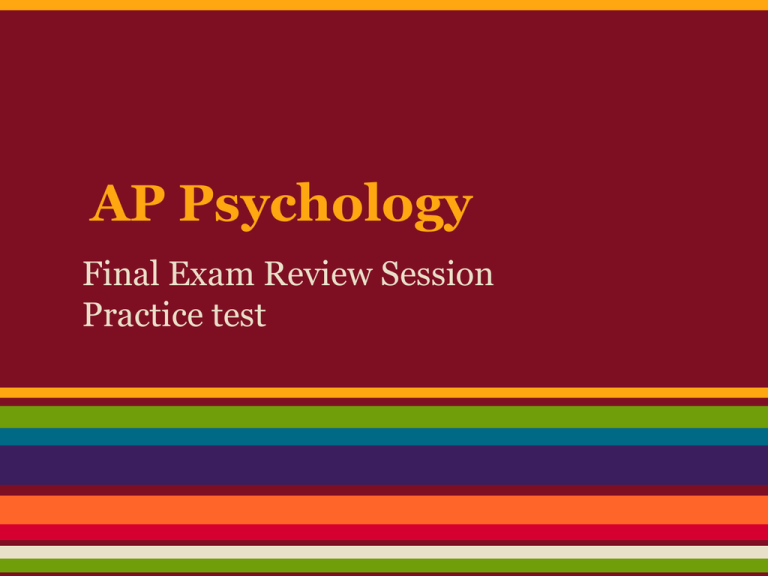
AP Psychology
Final Exam Review Session
Practice test
Question #1
Which of the following is the most important detail of Wundt's early research
that established the psychology as a science?
A. Wundt was a member of the upper class, which helped his credibility.
B. Wundt wrote well and communicated results to large numbers of people
effectively.
C. Wundt set up a laboratory and focused on empirical evidence that could be
replicated.
D. Wundt worked outside the university system and was seen as an
independent thinker.
E. Wundt focused exclusively on observable behavior, not unobservable events
like thinking and consciousness.
C – Wundt set up the first psychological laboratory and his empirical, replicable
experiments are the reason he is called the father of the science of
psychology.
Question #2
Choosing 20 people at random from a large lecture class of 400 is an example
of which of the following?
A.
B.
C.
D.
E.
Random assignment
Random Sampling
Representative assignment
Representative sampling
Assignment to conditions
B – Choosing participants at random for a study is random sampling.
Assignment occurs when participants are assigned to control and
experimental groups. Representative sampling and assignment involve
purposefully making groups that represent a larger population.
Question #3
Damage to the occipital lobes of the brain would most likely affect which of the
senses?
A.
B.
C.
D.
E.
Hearing
Touch
Balance
Sight
Smell
D – Impulses from the eyes travel to the occipital lobe where they are perceived
as vision. If the occipital lobe is damaged, vision would most likely be
affected.
Question #4
A doctor examining a car crash victim in order to determine whether the crash
caused structural damage to the brain would use what kind of brain scan?
A.
B.
C.
D.
E.
MRI
PET
EEG
fMRI
EKG
A – MRI and CAT scans provide detailed information about the structure of
the brain (and other body parts). These scans would reveal any structural
brain damage caused by the car crash. The PET, EEG, and fMRI scans are
primarily used to detect brain function, not structure (although the fMRI
would also provide structural details). An EKG scan is unrelated to brain
function.
Question #5
Children who suffer brain damage may be able to regain their physical and
mental abilities more quickly than older brain damage patients due to which
of the following properties of the brain?
A.
B.
C.
D.
E.
Contralateral control
Klinefelter's syndrome
Effective psychological environment
Brain Lateralization
Brain plasticity
E – Dendrites grow more quickly in children, so brains of younger people are
more “plastic,” or changeable. A young person who suffers brain damage is
more able to make new connections in nondamaged parts of the brain and
regain lost functions. The other brain-related concepts listed are not related
to brain plasticity.
Question #6
Which of the following structures in the eye is most specifically responsible for
color vision?
A.
B.
C.
D.
E.
rods
optic nerve
cornea
cones
lens
D – Although all the structures listed are involved in vision (including color
vision), cones are uniquely involved. Cones are cells in the retina that
respond to wavelengths of light that we perceive as color.
Question #7
Turning up the volume on a music player changes which aspect of sound?
A.
B.
C.
D.
E.
Amplitude of the wave
Frequency of the wave
Pitch of the tone
Transduction of the tone
Energy of the sound
A – Volume is determined by the amplitude (height) of the sound wave. Wave
frequency determines the pitch of the sound.
Question #8
A musician's ability to make a distinction between two very similar pitches
depends on which of the following concepts?
A.
B.
C.
D.
E.
Absolute threshold
Signal detection theory
Bottom-up processing
Difference threshold
Frequency theory
D – Detecting the difference between two very similar pitches depends on the
difference threshold, the minimum difference between two stimuli that we
can perceive.
Question #9
REM sleep deprivation generally causes what kinds of side effects?
A.
B.
C.
D.
E.
Intense, prolonged periods of stage 3 and 4 sleep
Interference with memory tasks
Decreased sleep onset
Sleep apnea and night terrors
Heightened manifest dream content
B – People deprived of REM sleep have difficulty with memory tasks. REM
sleep deprivation does not increase stage 3 and 4 sleep (in fact, people
deprived of REM sleep more easily slip into sleep onset and REM sleep, not
deeper sleep stages like stage 3 and 4). REM deprivation is not related to
sleep apnea, night terrors, or manifest dream content.
Question #10
What is the first step in any example of classical conditioning?
A.
B.
C.
D.
E.
Following a response with a reinforcement or a punishment
Reinforcing an organism for a behavior similar to the desired behavior
Pairing an unconditioned stimulus with a conditioned stimulus
Rewarding a behavior with an unconditioned stimulus
Punishing behaviors other than the target behavior
C – Classical conditioning always starts with pairing a conditioned stimulus
(like a bell) with an unconditioned stimulus (like food). All the other
possible answers involve reinforcements and punishments, which are
involved in operant conditioning, not classical conditioning.
Question #11
A researcher who concludes that "people who watch graphic violence in films
are more likely to behave in violent ways than people who don't" is probably
researching which kind of learning?
A. Latent
B. Behavioral
C. Observational
D. Insight
E. Abstract
C – Observational learning theorists, like Albert Bandura, were primarily
concerned with how we learn through observing the actions of others
(rather than learning through direct rewards and punishments).
Question #12
How would a psychometrician interpret an IQ score of 145?
A. This score is slightly above the average score on most IQ tests.
B. This score is well below the standard average of 200 on IQ tests.
C. This score indicates that the person has high verbal intelligence but low
logical intelligence.
D. This score is three standard deviations above the average score of 100.
E. This score is high for a child, but it considered average or low for an adult.
D – 100 is the average score on IQ tests, with a standard deviation of 15. A
score of 145 is three standard deviations above the average, and is a very
high IQ score.
Question #13
Memory research indicates that memories may be physically stored in the brain
through strengthened connections between brain neurons. What is this
process called?
A.
B.
C.
D.
E.
proactive interference
Long term potentiation
state dependent memory
semantic memory
information processing model
B – Long-term potentiation is the process of strengthened connections between
brain neurons. After repeated firings, the connection is strengthened, and
the receiving neuron becomes more sensitive to the neurotransmitters from
the sending neuron.
Question #14
Seeing someone in line at the grocery store and remembering her or his name is
an example of which kind of retrieval?
A.
B.
C.
D.
E.
recognition
recall
episodic
semantic
retroactive
B – Recognition is the process of matching a current stimuli to something
already in memroy (e.g., seeing someone and recognizing whether you’ve
ever seen her or him before). Recall is retrieving information from memory
with an external cue (e.g., looking at someone and remembering his or her
name).
Question #15
Abraham Maslow's hierarchy of needs theorizes that each person is motivated
by what?
A.
B.
C.
D.
E.
desire to achieve in the eyes of others
Satisfying needs from the next step in the hierarchy
primary (physical) and secondary (emotional) needs
Homeostasis needs determined by our inner self
sex, thirst, hunger, and safety, in that order
B – Maslow’s hierarchy of needs predicts that people are motivated to achieve
the next step in the hierarchy of needs. The order of the hierarchy is
physiological needs, safety needs, love needs, esteem needs, and finally selfactualization.
Question #16
Which kinds of motivations are best encourage positive behaviors to persist
over long periods of time?
A.
B.
C.
D.
E.
primary drives
secondary drives
achievement motivation
intrinsic motivation
extrinsic motivation
D – Intrinsic motives (such as enjoyment or satisfaction) are associated with
behaviors that continue over a long period of time. Extrinsic motivations
(e.g., rewards, such as money) are effective in the short term, but behaviors
slow down or stop after some time since most extrinsic rewards are
temporary.
Question #17
Which of the following newborn reflexes help infants find and eat food?
A.
B.
C.
D.
E.
Babinski
Moro
attachment
conservation
rooting
E – Infants are born with the rooting reflex, which causes baby to turn her or
his head toward something that touches the cheek. This reflex can help a
baby find the mother’s nipple in order to eat.
Question #18
Which developmental stage theory explained how experiences in infancy,
childhood, adolescence, adulthood, and old age influence later personality
characteristics?
A.
B.
C.
D.
E.
Piaget's cognitive development theory
Erikson's psychosocial stage theory
Kohlberg's moral development theory
Ainsworth's social attachment theory
Harlow's social attachment theory
B – Erikson examined the major social experiences at all stages of life and
theorized how these major experiences (which he described in eight stages)
impact personality.
Question # 19
According to Sigmund Freud, what is the dominant factor determining our
personality traits?
A.
B.
C.
D.
E.
secondary drives and needs
genetic and nutritional factors
unconscious conflicts
parenting styles
positive and negative reinforcements
C- Freud believed that unconscious conflicts (such as fixations and defense
mechanisms) determined our personalities.
Question #20
A pencil and paper personality test that places a person in one of the several
personality categories (such as extrovert/introvert,etc.) is based on which
personality theory?
A.
B.
C.
D.
E.
psychodynamic
trait
biological
behaviorist
social cognitive
B – Trait theorists believe that personalities can be described through a
combination of a small number of factors, or traits. Trait theorists often use
pencil and paper tests to assess personality, and the results of these tests
indicate that the person falls in specific personality categories
Question #21
Which of the following kinds of personality theorists is the most likely to use a
projective test?
A.
B.
C.
D.
E.
social cognitive
behaviorist
humanist
psychoanalyst
trait
D – Psychoanalysts might use a projective test in order to try to uncover
unconscious conflicts and motives. The theory of the projective test is that a
person will “project” their unconscious conflicts and desires on to vague and
ambiguous stimuli (such as inkblots).
Question #22
The ability to solve a new computer game based on logical puzzles probably
depends on which kind of intelligence?
A.
B.
C.
D.
E.
fluid intelligence
crystallized intelligence
aptitude intelligence
achievement intelligence
multiple intelligence
A – Fluid intelligence is the ability to solve novel, abstract problems. A new
logic-based computer game probably depends on this kind of intelligence,
rather than crystallized intelligence, which is the ability to use previously
acquired knowledge to solve problems.
Question #23
A person who experiences flashbacks and nightmares after being involved in a
serious car accident is likely to be diagnosed with which kind of
psychological disorder?
A.
B.
C.
D.
E.
somatoform disorder
dissociative disorder
schizophrenic disorder
personality disorder
anxiety disorder
E – The symptoms described best match post-traumatic stress disorder, which
is a kind of anxiety disorder.
Question#24
Psychogenic amnesia and fugue states are both indications of which kind of
psychological disorder?
A.
B.
C.
D.
E.
schizophrenia
anxiety
mood
dissociative
personality
D – Psychogenic amnesia and fugue states are both categorized as dissociative
disorders. All dissociative disorders involve disruptions in our
consciousness, such as the loss of memory that occurs during amnesia and
fugue.
Question #25
In what way would a person diagnosed with schizophrenia most likely differ
from a person diagnosed with a dissociative disorder?
A. A person with schizophrenia is likely to have more than one personality
B. A person diagnosed with a dissociative disorder is likely to have delusions
C. A person diagnosed with schizophrenia is likely to experience hallucinations
D. A person diagnosed with a dissociative disorder may have difficulty keeping
a job
E. A person with schizophrenia is likely to be split from reality
C – Schizophrenia is associated with hallucinations and delusions. Both
schizophrenia and dissociative disorders involve splits from reality, and
both disorders are very disruptive and may interfere with a career and jobs.
Question #26
Why are psychoanalysts sometimes interested in talking with a patient about
dreams?
A. Psychoanalysts discovered that neurotransmitter abnormalities sometimes cause
dream disturbances
B. Since all people are striving for self-actualization, psychoanalysts look at the cognitive
obstacles in dreams
C. Nonproductive counterconditioning behaviors are sometimes revealed in dreams
D. Some psychoanalysts believe that dream symbols represent unconscious conflicts
E. Dreams reflect variations in brain waves during REM sleep
D – Psychoanalysts, like Sigmund Freud, feel that dreams consist of symbols that reveal
unconscious conflicts. This kind of analysis is seen as useful because psychotherapists
believe that personality and personality difficulties, are caused by unconscious
conflicts.
Question #27
Which of the therapies listed below is no longer used to treat patients?
A. Electroconvulsive shock therapy
B. Implosive therapy
C. Free association
D. Gestalt therapy
E. Prefrontal lobotomy
E – Lobotomies were used at one time to treat a variety of disorders, but this
kind of serious psychosurgery was stopped when drug therapies became
more common and precise.
Question #28
A nonprofit environmental group includes a free gift of address labels in a letter
asking for contributions. Which social psychological principle is the
nonprofit group trying to use to increase contributions?
A. Self-fulfilling prophecy
B. Stable attribution
C. Compliance strategy
D. Fundamental attribution error
E. Out-group homogeneity
C – Including the free address labels is an example of norm of reciprocity, one
of the compliance strategies. People are more likely to help if they feel
someone has done them a favor, such as including a gift in a letter asking for
contributions.
Question #29
What kinds of factors are ignored or de-emphasized when people commit the
fundamental attribution error?
A. Dispositional
B. Situational
C. Social
D. Cognitive
E. Behavioral
B – When people commit the fundamental attribution error, they ignore the
situational factors that may influence another person’s behavior and instead
attribute the person’s behaviors to their inner disposition.
Question #30
Sherif's Robbers Cave study indicated that which of the following principles
best helps reduce tensions between groups?
A. Superordinate Goals
B. Diffusion of responsibility
C. Group polarization
D. Deindividualization
E. Groupthink
A – Superordinate goals (goals that all groups need to work together on to
accomplish) reduce tensions between groups. The other concepts listed do
not relate to group tensions.
Question #31
What makes the psychoanalytic perspective different from the other
psychological perspectives?
A. Psychoanalysts focus on the unconscious mind
B. Psychoanalysts relies on the scientific method
C. The process of psychoanalysts takes a long time is focused on individuals, not groups
D. The research psychoanalysis is based on primarily involves people with psychological
disorders
E. Psychoanalysis is the only perspective to involve treatment of psychological disorders
A – Psychoanalysis is based on the study of the unconscious mind, a part of our
consciousness that we are not consciously aware of. The other possible answers are
not unique to psychoanalysis as compared to the other perspectives.
Question #32
Which of the following would a researcher need to use to determine if the
difference between the mean scores of experimental and control groups was
significant?
A. Descriptive statistics
B. Inferential statistics
C. Field experiment
D. Standard deviation
E. Counterbalancing
B – Inferential statistics are used to examine distributions of scores in order to find
statistically significant differences. Descriptive statistics (like standard deviation)
describe sets of scores, but used alone cannot help make judgments about the
significance of differences between sets of scores. Field experiments and
counterbalancing are terms related to research methodology and aren’t relevant to
the question.
Question #33
Someone with brain damage who has difficulty making the muscle movements
needed to produce accurate speech might have damage to which area of the
brain?
A. Wernicke's area
B. Hippocampus
C. Broca's area
D. Amygdala
E. Gage's area
C – Broca’s area of the brain (located in the left frontal lobe in most people) helps control
the muscles in the jaw, throat, and tongue needed to produce speech. Wernicke’s area
is also involved in spoken language but is involved with meaning and interpretation
of language. The hippocampus and amygdala areas of the brain are not involved in
spoken language. Gage’s area is not an area of the brain (Phineas Gage was a famous
case study in brain function, but is not related to a specific area of the brain).
Question #34
The case study of Phineas Gage's brain injury was significant for which of the
following reasons?
A. Gage's accident was one of the first to be treated with drugs that alter the
neurotransmitters in the brain
B. It was one of the first well-documented examples of a specific brain area being
associated with a set of physical and emotional changes
C. This accident provided psychiatrists with one of the first opportunities to treat a braindamaged patient with psychotherapeutic techniques
D. The CAT scan was used for the first time in the Phineas Gage case to document the
extent of brain injury
E. The case of Phineas Gage demonstrated that brain injury rarely causes primarily
effects physical abilities, not mood or emotional
B – The doctors who treated Phineas Gage documented what areas of the brain were
damaged and how Gage’s physical and emotional characteristics changed after the
acccident. This was one of the first cases to tie a specific brain area to a specific
function.
Question #35
Which classical conditioning term best describes the following scenario: Later
in his classical conditioning experiments, Ivan Pavlov's dogs began to
salivate whenever they heard any sound similar to a bell, such as a doorbell
or someone accidentally clinking a water glass.
A. Discrimination
B. Spontaneous recovery
C. Trace conditioning
D. Generalization
E. Unconditioned response
D – Generalization occurs in classical conditioning when an organism responds
to any stimuli similar to the conditioned stimuli, such as salivating to any
sound similar to a bell.
Question #36
Why might a researcher use a variable ratio of reinforcement rather than a
fixed ratio?
A. Fixed ratio schedules of reinforcements are more time intensive
B. Variable ratio schedules of reinforcements produce results more quickly
C. Variable ratio schedules of reinforcements avoid problems such as
generalization and the Premack principle
D. Variable ratio schedules of reinforcements allow researchers to use both
classical and operant conditioning
E. Variable ratio schedules of reinforcement are more resistant to extinction
than fixed schedules
E – Organisms trained using variable ratio schedules of reinforcements will
continue to perform the desired behavior for a long time after
reinforcement is stopped (i.e., extinction of the behavior is delayed).
Question #37
Which of the following is an example of an implicit memory?
A. Describing the taste of the cake at your last birthday party
B. Remembering how to tie a tie
C. Recalling the name of your junior high school shop teacher
D. Recognizing a celebrity
E. Repeating the name of your first pet
B – Explicit memories are memories of facts and events. Implicit memories (or
nondeclarative memories) are memories of procedures or skills that we may
not even realize we have, such as the skill of tying a tie.
Question #38
A psychology teacher who believes that all students want to learn and creates a
classroom culture that encourages this intrinsic motivation is using which
kind of management style?
A. Approach-avoidance
B. James-Lange
C. Canon-Bard
D. Theory X
E. Theory Y
E – Theory Y managers believe that workers want to do good work and set
policies in order to support worker efforts to improve and do quality work.
Theory X managers believe that workers will only produce if given rewards
and punishments. The other options listed as answers are not associated
with management style theory.
Question #39
Which of the following statements best describes an important difference
between authoritarian and authoritative parenting styles?
A. Authoritarian parents use clear rules and enforce those rules consistently
B. Parents using the authoritative style allow children to set and enforce their own rules
in order to encourage independence
C. Authoritative parents set and enforce rules, but explain and emphasize the rationale
behind the rules
D. Children who grow up in authoritative households are likely to be less independent as
adults because they are not used to making decisions
E. Authoritative parents set fewer rules than Authoritarian parents do, but they are more
likely to enforce the rules with stricter punishments and more extensive rewards
C – Authoritative parents set and enforce rules for children, but they talk about the
reasons behind and the importance of the rules and help children understand the
rules and participate in discussions about good and bad behavior.
Question #40
Which of the following is a common criticism of Freud's personality theory?
A. Freud's research was based mainly on students in his classes and wasn't representative
B. The theory was focused on the psychologically healthy and did not apply well to people
with psychological disorders
C. Personality is too complex to be studied using the scientific experiments Freud used
D. Genetics theory was not advanced enough in Freud's time to be used as he tried to
E. The evidence for Freud's method was based only on his therapy sessions and was not
tested scientifically
E – Freud’s theory was build on case studies from his psychoanalytic practice and was not
tested empirically. In fact, his claims about the unconscious could not be tested
experimentally because the unconscious by definition is not accessbile to conscious
investigation.
Question #41
Which of the following is one of the key factors that differentiate major
depression from periods of sadness that everyone experiences?
A. Major depression is indicated by specific changes in the brain.
B. People who experience major depression are sad for longer than two weeks without an
obvious cause.
C. Individuals diagnosed with major depression experience sadness along with episodes
of heightened emotions and mania.
D. All mood disorders, like major depression involve tolerance and withdrawal of
controlled substances.
E. Normal periods of sadness are much less intense than the sadness associated with
major depression.
B – In order to be diagnosed with major depression a person has to have a depressed
mood that lasts for longer than two weeks without an obvious cause.
Question #42
Which of the following was one of the factors that increased conformity
in Asch’s studies?
A. Presence of the authority figure
B. Level of shock administered
C. Placebo effect
D. Size of the group
E. Expectations about conformity
D – Asch found that conformity increased if the group was made up of
three or more people.
Question #43
Why can experiments determine causal relationships when no other
research method can?
A. Experiments are more precise than the other research methods.
B. Experiments isolate the effects of independent variables on dependent
variables.
C. Experiments typically involve more participants than other research
methods do.
D. Experiments take place in more realistic, real-life settings.
E. Experiments involve precise descriptive and inferential statistical methods.
B – Experiments use experimental and control groups to isolate what happens
when a specific variable (independent variable) is changed and to measure
the impact on the variable that changes as a result (dependent variable).
The other options listed are either not true about the experimental method
or are not unique to the experimental method.
Question #44
The case study of Phineas Gage’s brain injury was significant for which
of the following reasons?
A. Gage’s accident was one of the first to be treated with drugs that alter the
neurotransmitters in the brain.
B. It was one of the first well-documented examples of a specific brain area being
associated with a set of physical and emotional changes.
C. This accident provided psychiatrists with one of the first opportunities to treat a braindamaged patient with psychotherapeutic techniques.
D. The CAT scan was used for the first time in the Phineas Gage case to document the
extent of brain injury.
E. The case of Phineas Gage demonstrated that brain injury primarily affects physical
abilities, not mood or emotion.
B – The doctors who treated Phineas Gage documented what areas of the brain were
damaged and how Gage’s physical and emotional characteristics changed after the
accident. This was one of the first cases to tie a specific brain area to a specific
function.
Question #45
Withdrawal symptoms are most directly caused by which of the
following processes?
A. Tolerance
B. Dissociation
C. Activation-synthesis
D. Role theory
E. Antagonists
A – Most drugs produce increased tolerance with repeated uses – the need for increasing
amounts of a drug in order to produce the same physiological effects. This tolerance
gradually changes the levels of specific neurotransmitters in the brain, so when a
person stops using the drug, withdrawal symptoms occur as the body and brain
readjust and compensate for altered levels of these neurotransmitters. The other
concepts listed in the answers are not related to the tolerance-withdrawal cause-effect
cycle.
Question #46
What is the major difference between negative reinforcement and punishment?
A. Punishments are used with nonhuman animals, and negative reinforcements are used
with humans.
B. Negative reinforcements are used in classical conditioning, and punishments are used
in operant conditioning.
C. Punishments are primarily used when training an organism to perform a behavior and
negative reinforcements are used to train an organism to stop performing a behavior.
D. Negative reinforcements are more effective than punishments but take longer to use.
E. Punishments decrease the frequency of a behavior and negative reinforcements
increase the frequency of a behavior.
E – Punishments are defined as stimuli that decrease the likelihood than an organism
will perform the behavior that preceded the punishments. Negative reinforcements
reinforce a behavior, increasing the likelihood the behavior will be repeated. They
reinforce the behavior by taking away an aversive stimulus (e.g., an aspirin takes
away a headache, which makes the person more likely to take an aspirin in the
future).
Question #47
A research participant eats half a bowl of M&M candies, and then stops
eating. How would a motivation researcher using drive reduction
theory explain this participant’s behavior?
A. Humans are instinctively driven to eat sugar and fat when presented to them.
B. The Yerkes-Dodson law explains that people will eat food when presented to them, but
usually in moderate amounts in order to avoid being perceived as selfish.
C. The primary drive of hunger motivated the person to eat, and then stop when she/he
regained homeostasis.
D. The research participant was satisfying the second step on the hierarchy of needs: food
needs.
E. Each person uses incentives in order to determine what to be motivated to do. This
person decided on a hunger incentive and ate half the candies.
C – Drive Reduction theory states that we are motivated by primary drives (like hunger)
and secondary drives, and that we act to satisfy these drives until we regain a state of
homeostasis (balance – in this case, we are no longer hungry). The other options each
relate to a different motivation theory.
Question #48
How would Piaget describe the process of learning something new using terminology
from his cognitive development theory?
A. When we can’t assimilate new information, we change our schemas through
accomodation.
B. As we encounter new social situations, we either develop healthy or unhealthy
personality characteristics in order to cope with social demands.
C. Humans develop increasing abilities to think about moral choices, and our ability to
think about the rights of others develops over time.
D. Rewards and punishments for behaviors are the major influence on learning in
humans.
E. The interaction between nature and nurture determines that genetic influcnces are a
major cause of the pace of learning and learning difficulties.
A – Piaget described schemas (the ways we think about the world) as going through a process of
assimilation and accommodation. When we encounter something new in the world, we first
try to use our existing schemas to understand it (assimilation). If that doesn’t work, we may
have to change or expand our schemas in order to deal with the new object, event, or idea
(accommodation). We learn through accommodation, as our schemas change and become
more sophisticated.
Question #49
What would a psychometrician conclude about a personality test that
tells a person she is an extreme extrovert the first time she takes the
test and an extreme introvert the next time she takes it?
A. This personality test has low reliability but high validity.
B. The test is probably high in construct validity but isn’t very
predictive.
C. These test norms and standardization probably need improvement.
D. The results indicate that the test has low test-retest reliability.
E. Like most personality tests, this test is most likely an aptitude rather
than an achievement test.
D – Test-retest reliability is a measure of a tests ability to deliver
similar results each time it is administered to the same person.
Question #50
What is the purpose of the Diagnostic and Statistical Manual of
Mental Disorders?
A. To describe the causes of psychological disorders
B. To explain the biomedical symptoms, causes, and cures related to psychological
disorders
C. To list diagnoses and symptoms so that psychologists and others can help diagnose
psychological disorders
D. To summarize research studies regarding psychological disorders and how these
diagnoses relate to one another
E. To discuss theories related to the causes of psychological disorders and how the
theories lead to cures
C – The DSM lists the official names of diagnoses and exact symptoms associated with
these diagnoses so that psychologists and psychiatrists can reliably diagnose patients.
The DSM does not address causes of psychological disorders.



